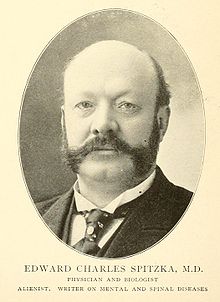Edward Charles Spitzka: Difference between revisions
No edit summary |
No edit summary |
||
| Line 1: | Line 1: | ||
[[File:Edward Spitzka.jpg|Edward C. Spitzka|thumb]] |
[[File:Edward Spitzka.jpg|Edward C. Spitzka|thumb]] |
||
'''Edward Charles Spitzka''' (November 10, 1852 - January 13, 1914) was an eminent American neurologist, psychiatrist, anatomist |
'''Edward Charles Spitzka''' (November 10, 1852 - January 13, 1914) was an eminent American neurologist, psychiatrist, and anatomist. He was the author of the landmark psychiatric manual ''"Treatise on Insanity,. Its Classification, Diagnosis and Treatment,"'' published in 1883. |
||
| ⚫ | |||
| ⚫ | Spitzka was born in New York City, the son of Charles A. Spitzka and Johanna née Tag. He attended Public School No. 35, the College of the City of New York, and the Medical Department of the [[University of the City of New York]], where he graduated in 1873. He spent the next three years in Europe, where he studied at the medical schools of the [[University of Leipzig]] and the [[University of Vienna]]. From 1874 to 1875 he served as an assistant to the chair of embryology at the [[University of Vienna]]. |
||
| ⚫ | |||
| ⚫ | Dr. Spitzka was a professor of nervous and mental diseases and of medical jurisprudence |
||
| ⚫ | In 1876 Spitzka returned to New York City, specializing in the diagnosis and treatment of internal diseases, particularly of the human nervous system. He practiced surgery at [[Mount Sinai Hospital, New York|Mount Sinai Hospital]] and was a consulting neurologist to the North-Eastern Dispensary and St. Mark's Hospital. |
||
| ⚫ | |||
| ⚫ | Dr. Spitzka was a professor of nervous and mental diseases and of medical jurisprudence at the New York Post-Graduate Medical College from 1882 to 1887. In 1890, Spitzka served as President of the [[American Neurological Society]]. In 1883/1884, he served as President of the [[New York Neurological Society]]. |
||
| ⚫ | Spitzka published many scientific papers on the subjects of comparative neuroanatomy and psychiatry. He pioneered studies of the anatomy of the human nervous system, discovering the interoptic lobes of saurians in the human brain; observing the absence of pyramid tracts in the ce-tacea, and identifying many physiological characteristics of the human brain. |
||
[[File:Spitzka Insanity.jpg|thumb|Title page of Insanity, Its Classification, Diagnosis and Treatment, published 1883.]] |
|||
Spitzka was the father of the noted alienist, [[Edward Anthony Spitzka]]. He died at his home after a long illness. |
|||
Dr. Spitzka died on [[stroke]] in his house, after a long illness (probably cancer of oral cavity). |
|||
==Bibliography== |
==Bibliography== |
||
* Haines, D E. "Spitzka and Spitzka on the brains of the assassins of presidents". Journal of the history of the neurosciences 4 (3-4): 236–66. ISSN 0964-704X. {{DOI|10.1080/09647049509525641}} PMID 11619027 |
* Haines, D E. "Spitzka and Spitzka on the brains of the assassins of presidents". Journal of the history of the neurosciences 4 (3-4): 236–66. ISSN 0964-704X. {{DOI|10.1080/09647049509525641}} PMID 11619027 |
||
==References== |
==References== |
||
Revision as of 20:37, 8 February 2011

Edward Charles Spitzka (November 10, 1852 - January 13, 1914) was an eminent American neurologist, psychiatrist, and anatomist. He was the author of the landmark psychiatric manual "Treatise on Insanity,. Its Classification, Diagnosis and Treatment," published in 1883.
Spitzka was born in New York City, the son of Charles A. Spitzka and Johanna née Tag. He attended Public School No. 35, the College of the City of New York, and the Medical Department of the University of the City of New York, where he graduated in 1873. He spent the next three years in Europe, where he studied at the medical schools of the University of Leipzig and the University of Vienna. From 1874 to 1875 he served as an assistant to the chair of embryology at the University of Vienna.
In 1876 Spitzka returned to New York City, specializing in the diagnosis and treatment of internal diseases, particularly of the human nervous system. He practiced surgery at Mount Sinai Hospital and was a consulting neurologist to the North-Eastern Dispensary and St. Mark's Hospital.
Dr. Spitzka was a professor of nervous and mental diseases and of medical jurisprudence at the New York Post-Graduate Medical College from 1882 to 1887. In 1890, Spitzka served as President of the American Neurological Society. In 1883/1884, he served as President of the New York Neurological Society.
Spitzka published many scientific papers on the subjects of comparative neuroanatomy and psychiatry. He pioneered studies of the anatomy of the human nervous system, discovering the interoptic lobes of saurians in the human brain; observing the absence of pyramid tracts in the ce-tacea, and identifying many physiological characteristics of the human brain.

Spitzka was the father of the noted alienist, Edward Anthony Spitzka. He died at his home after a long illness.
Bibliography
- Haines, D E. "Spitzka and Spitzka on the brains of the assassins of presidents". Journal of the history of the neurosciences 4 (3-4): 236–66. ISSN 0964-704X. doi:10.1080/09647049509525641 PMID 11619027
